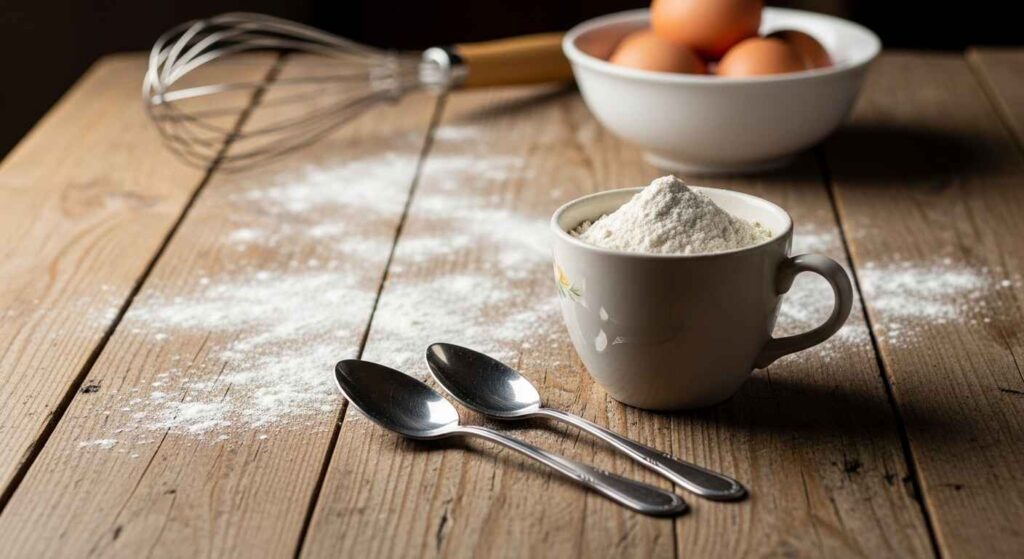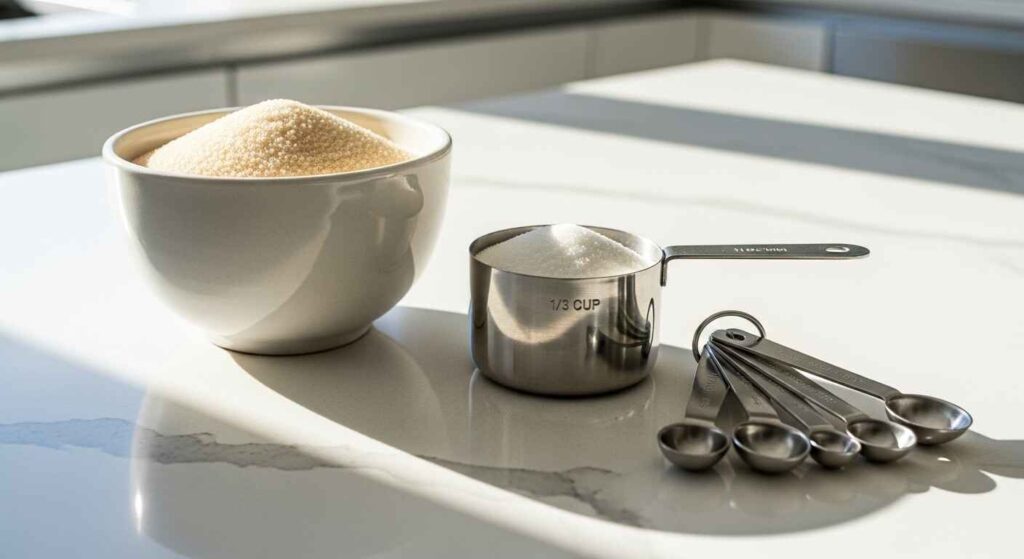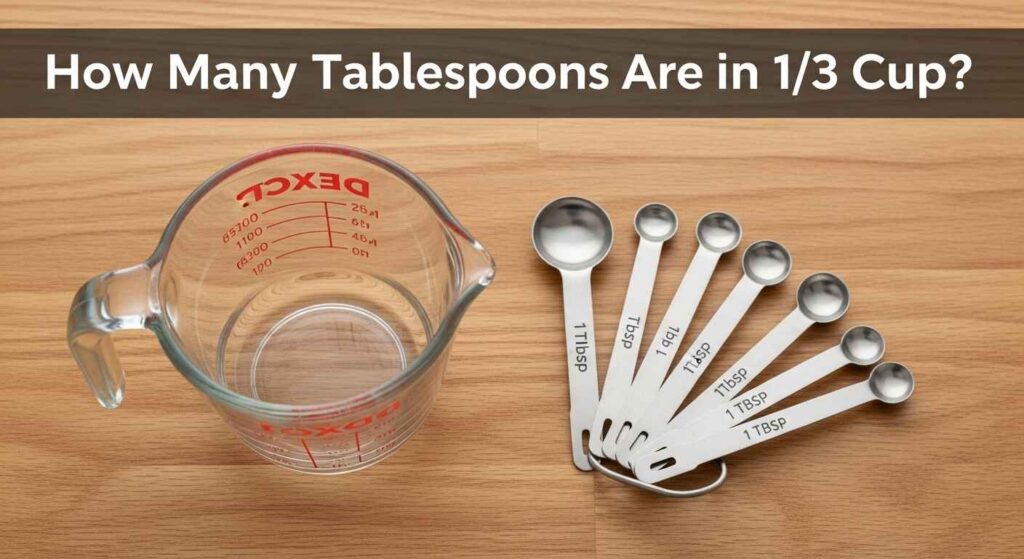If you’re asking yourself, “How many tablespoons are in 1/3 cup?”, the exact answer is 5 tablespoons plus 1 teaspoon. That works out to about 5.33 tablespoons. You can also measure it as 16 teaspoons.
This quick conversion is useful for anyone who doesn’t have a 1/3 measuring cup at home. But beyond the numbers, knowing how to convert cups into tablespoons can save recipes, improve accuracy in cooking, and make you more confident in the kitchen.
Why the Cup Equals 16 Tablespoons: A Quick Background
The U.S. measuring system is based on standard kitchen volumes:
- 1 cup = 8 fluid ounces
- 1 cup = 16 tablespoons
- 1 tablespoon = 3 teaspoons
This structure was created to simplify recipe scaling. Once you know the base unit (1 cup = 16 tablespoons), you can divide or multiply easily. That’s why 1/3 cup works out to a little over 5 tablespoons.
US vs UK vs Australian Measurements: Does 1/3 Cup Change?
Here’s where many guides fall short — not all countries define a “cup” the same way:
- U.S. cup: 240 ml (16 tbsp)
- UK cup (historical, rarely used now): 284 ml
- Australian cup: 250 ml
This means that in Australia, 1/3 cup = about 5 tbsp + 1 ½ tsp, since their cup is slightly larger. Recipes written in international cookbooks may differ, so always check if the recipe uses U.S. or metric/Australian measurements.

Quick Conversion Chart
| Cups | Tablespoons | Teaspoons | Notes |
| 1 cup | 16 tablespoons | 48 tsp | Standard U.S. measure |
| 3/4 cup | 12 tablespoons | 36 tsp | Common in baking |
| 2/3 cup | 10 tbsp + 2 tsp | 32 tsp | Just under 11 tbsp |
| 1/2 cup | 8 tablespoons | 24 tsp | Half cup |
| 1/3 cup | 5 tbsp + 1 tsp | 16 tsp | Focus conversion |
| 1/4 cup | 4 tablespoons | 12 tsp | Quarter cup |
| 1/8 cup | 2 tablespoons | 6 tsp | Smallest cup measure |
This chart helps if you want to quickly swap cups for tablespoons in any recipe.
Everyday Comparisons: What Does 1/3 Cup Look Like?
Sometimes, you don’t want to do the math. You just want to visualise it. Here are a few comparisons:
- Butter: 1/3 cup butter = about 75 g or 5 tbsp. That’s around two-thirds of a standard butter stick (in the U.S.).
- Rice or grains: 1/3 cup dry rice is roughly a small handful.
- Liquids: For milk, oil, or water, 1/3 cup is just under half of a small coffee mug.
These comparisons help when you’re in a hurry and don’t want to measure spoon by spoon.
Step-by-Step Math: How to Convert Cups to Tablespoons
Here’s how to calculate it:
- Start with the base: 1 cup = 16 tablespoons.
- Divide by 3: 16 ÷ 3 = 5.33 tablespoons.
- Break down the decimal: 0.33 tbsp ≈ 1 teaspoon.
- Combine: 1/3 cup = 5 tbsp + 1 tsp.
Understanding this math makes it easier to convert other cup fractions (like 2/3 or 3/4) into spoons without a chart.
Substitutions: Measuring 1/3 Cup Without Cups or Spoons
No measuring cups? No problem. Try these hacks:
- Using tablespoons: Measure 5 tablespoons + 1 teaspoon.
- Using 1/4 cup: Fill 1/4 cup (4 tbsp), then add 1 tbsp + 1 tsp.
- Using 1/2 cup: Fill a 1/2 cup, then remove 2 tbsp + 2 tsp.
- Using teaspoons: Count out 16 teaspoons.
- Using a mug: A standard coffee mug (240 ml) = 1 cup. So 1/3 cup = about 1/3 of that mug.
- Using weight (grams): For flour, sugar, or butter, look up weight conversions (e.g., 1/3 cup sugar ≈ 67 g).
Why Accuracy Matters in Cooking and Baking
- Baking: Small measurement errors can change texture. Too much flour = dry cakes; too much liquid = dense dough.
- Cooking: Soups and sauces may end up too salty or bland if ratios are off.
- Nutrition: For calorie-counting or meal prep, a small difference (like an extra tablespoon of oil) can add 120 calories.
That’s why precise conversions like 1/3 cup = 5 tbsp + 1 tsp really matter.

Common Kitchen Measurement Conversions
Here’s a wider list of helpful conversions:
- 1 tbsp = 3 tsp
- 1/2 tbsp = 1 ½ tsp
- 1/4 cup = 4 tbsp
- 1/2 cup = 8 tbsp
- 2/3 cup = 10 tbsp + 2 tsp
- 3/4 cup = 12 tbsp
- 1 pint (2 cups) = 32 tbsp
Measuring Tips for Best Results
- Dry vs liquid: Use proper dry cups for flour/sugar, liquid cups for oil/milk.
- Level off: Use a flat edge to scrape excess dry ingredients.
- Don’t pack flour: Spoon into the cup, then level. Scooping compresses it.
- Double-check small amounts: Teaspoons and tablespoons can easily overflow — accuracy matters.
Nutrition & Meal Prep: Why Conversions Help
If you track calories or macros, knowing conversions is essential:
- 1/3 cup oats = ~28 g carbs, 4 g protein.
- 1/3 cup olive oil = ~630 calories.
- 1/3 cup rice (dry) = ~225 calories.
Being able to switch between cups, tablespoons, and grams helps keep portion sizes accurate.
Conclusion
The exact conversion for 1/3 cup is 5 tablespoons plus 1 teaspoon, or 16 teaspoons in total. This means you can still measure accurately even if you don’t have a 1/3 cup available. Using spoons is an easy solution for cooking and baking, while a kitchen scale gives the most precise results. With this guide and the included chart, you now have a simple way to measure 1/3 cup confidently in any recipe
Related Questions (FAQs)
Here are FAQs:
How many teaspoons are in 1/3 cup?
There are 16 teaspoons in 1/3 cup.
Is 1/3 cup exactly 5 tablespoons?
No, it’s 5 tablespoons plus 1 teaspoon.
Can I use grams instead of spoons?
Yes, but it depends on the ingredient (flour ≠ , sugar ≠ , butter).
What if I don’t have any measuring tools?
Use visual comparisons — about one-third of a coffee mug or two-thirds of a U.S. butter stick.
Do international cup sizes change the conversion?
Yes, in Australia, a cup is 250 ml, so 1/3 cup is slightly more than the U.S. version.

